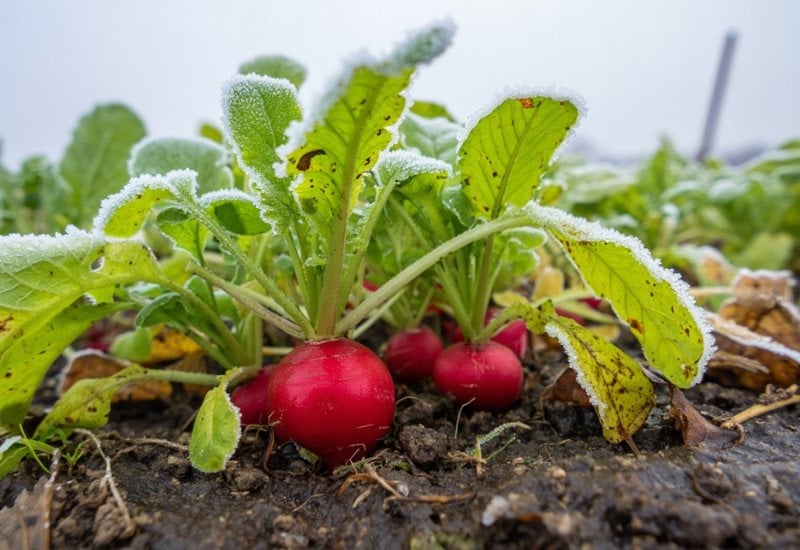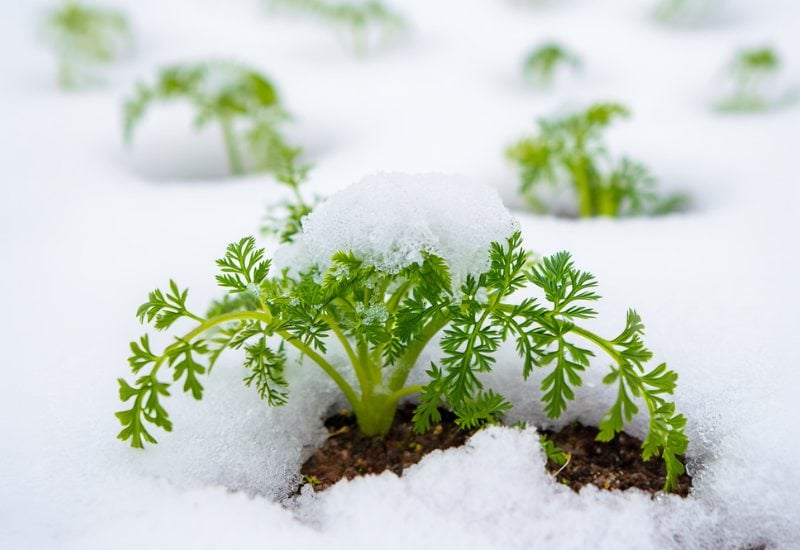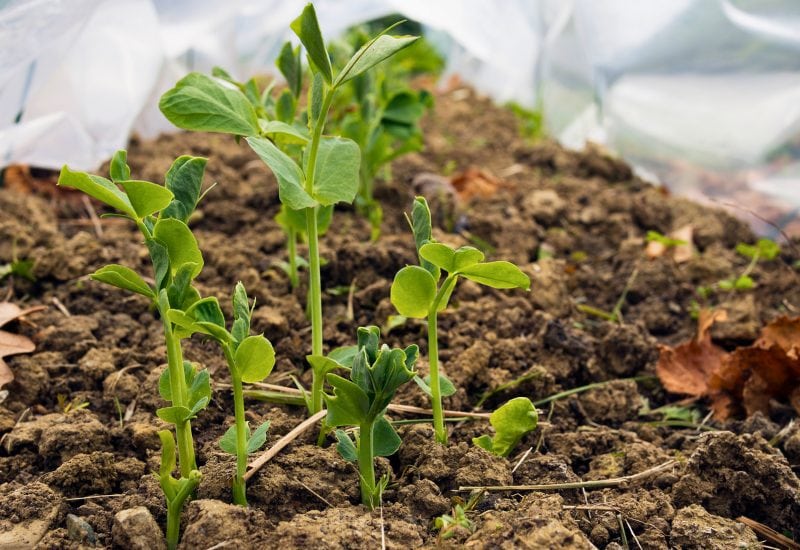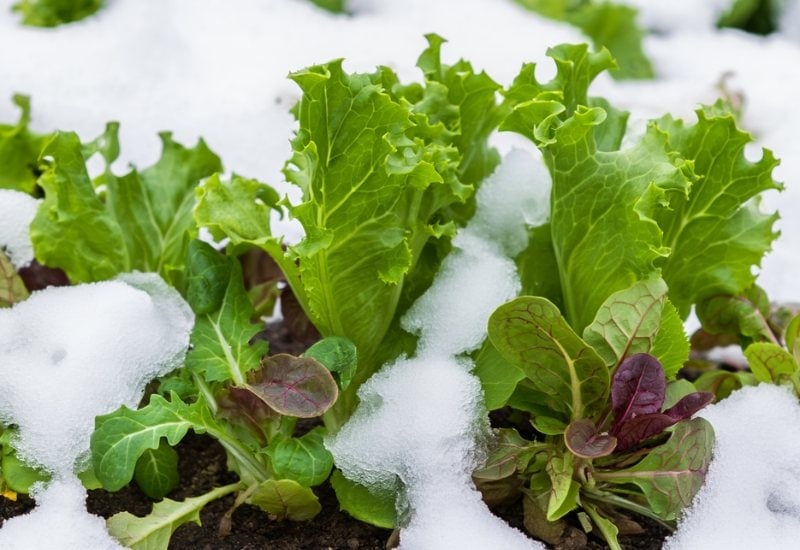
If you’ve got the gardening bug flowing through your veins turning your thumb green, then you’re likely wondering what crops you can grow in spring even if there’s a little snow on the ground.
The good news is with proper preparation and thoughtful selection, there are several seeds you can start as soon as the soil can turn.
Prepping the Soil

Proper soil prep is absolutely essential to your success when planting seeds in the often-cold conditions of early spring.
Step One: Remove Mulch & Cover Layers
Mulch holds in moisture which can cause seeds to rot and potentially promote mold development. It also reduces the sun’s ability to warm the soil, which can impact germination time. Small rodents also like to forage under mulch in the desperate days of late winter and are more likely to find and eat your seeds in a planting bed partially covered by mulch.
Step Two: Vigorously Till & Amend the Soil

All seeds germinate best in loose soil. Especially ones started outdoors in cold weather. Adding a little bit of vermiculite and bioavailable fertilizers will go a long way toward making sure the seeds have the nutrients they need for the impending day when they finally germinate.
Step Three: Have a Protective Cover Available

A protective layer of plastic, a portable plexiglass cold frame, or some other type of removable row cover is very handy for protecting your planting bed when a spring snowstorm, heavy rainstorm, or cold snap hits. The goal is to keep the seeds and/or seedlings from being flooded out, smashed flat, or held in enough heat to get them through a freezing night.
The Best Seeds to Plant Even with Snow on the Ground
When choosing seeds to plant in late winter or early spring, you want to choose crops that can tolerate temperatures of 32 degrees, and perhaps survive for a short time in frozen soil down to 20 degrees. You also need to factor in their ideal germination temperatures. In a perfect world, you can then time your seed sowing for warm days, in hopes that you’ll have hardy seedlings by the time the next cold snap hits.
Radishes

Radishes and French radishes in particular are harder to kill in cold weather than the Terminator. They also bolt and get woody in warm weather as soon as mid-spring. So, getting them in the soil, even if there’s a risk of snow on the ground in the future, will give you the best chance of having a great spring crop of radishes.
Carrots

Carrots are another cold-hardy crop you can grow from seed even in cold weather. However, they can be a little fickle when they choose to germinate. Dark, loose soil, that’s free of clay, and a clear row cover will give you the best germination rates when sowing carrot seeds in cold ground.
Pro Tip
Covering carrots with a row cover or plastic sheeting suspended over the planting bed until they germinate will increase the chances of success. It will also keep them from being waterlogged or washed away by any heavy spring rains.
Snow Peas

As the name implies snow peas can easily survive with snow on the ground and can even handle temperatures down to 20 degrees. The problem is that they prefer to germinate in soil that’s 65+ degrees. They can also rot easily in cold wet soil, and the pea seeds are a favorite snack of rodents everywhere.
So, if you’re going to directly sow them in the soil, you want to pick a stretch of warm days and cover the soil to concentrate the heat while blocking out rodents.
Pro Tip
You can start snow peas and sugar snap peas in a moist paper towel in a heated germination tray. Once the first roots start to emerge, you can gently transplant them outside into a 2-inch deep hole in the soil. At this point, rodents will leave them alone and the active sugars in the germinating pea seed is usually enough to keep them from freezing, even if it snows.
Spinach

Spinach loves cool growing conditions, so it’s no surprise that you grow bountiful crops of it even when there’s a chance of snow on the ground. Spinach tends to bolt easily during mid-spring warm spells. So, getting a head start on it in late winter to early spring gives you the best chance for success.
Beets

Beets are another crop you can plant from seed when there’s still a risk of snow on the ground without worrying about losing them to a rogue cold snap. Ideally, you still want to plant them during a stretch of warm weather and take steps to keep hungry rodents from stealing the seeds.
Once they germinate, the high starch content of the beets will keep them from fully freezing down to temperatures near 20 degrees. They’ll simply stop growing as the frozen ground around won’t allow for water and nutrient uptake. When the weather turns warm again, they’ll spring back to life.
Lettuce and Mesclun Green

Most forms of lettuce and mesclun greens that you can cut and come again will tolerate snow on the ground. However, your best chance of success starts with germinating them during a stretch of warm weather.
Once lettuce and mesclun greens germinate and start to develop into leaves, you’ll need to take measures to make sure the weight of a stray snow shower doesn’t lay them flat. A row cover suspended over the planting bed or an improvised cold frame is usually sufficient.
Cilantro

Cilantro is an herb most people associate with summer, yet it actually prefers to grow in cold conditions. The trick is to germinate it in a small peat pot indoors, or sow it into the soil when the extended forecast calls for a string of days with high’s over 60 degrees. This will give the cilantro seeds their best chance to germinate.
Once it grows its first true leaves, cilantro can tolerate temperatures down to 25 degrees. It can even withstand a few days of light snow cover. However, you should try to cover the cilantro plants if more than an inch of snow is in the forecast, to keep the weight from crushing the seedlings flat.
Kale

Kale is another cold-hardy green that isn’t afraid of a little snow. I’ve even had kale plants survive being buried under 6 inches of snow for more than a week and still thrive for months afterward. You just have to remember that kale germinates best in warm soil, around 60 to 65 degrees.
Assuming you can plant it during a 4 to 5-day stretch of warm weather, the emergent kale seedlings should be remarkably resilient. The concern with planting kale seedlings in cold soil is that rodents love to sniff out the seeds and take them.
Frequently Asked Questions
How does cold weather affect germination?
Even most cold-hardy plants still prefer warm soil to germinate. When you sow seeds directly, there’s a risk of them rotting, or succumbing to soil fungus before they have a chance to germinate. This usually translates into a 45 to 50% germination rate. So, if you want a big crop, you might want to double sow your seeds. Especially if your area is prone to outdoor rodent problems.
Should I cover my seedlings with a portable cold-frame?
Covering cold-hardy planting beds with an improvised cold frame is a great way to improve seed germination rates. It can also help protect tender or leafy plants from being compressed by the weight of a passing snowstorm. My grandmother successfully gardened this way for over 50 years in the caprices of Minnesota’s spring weather.
However, cold frames can also concentrate heat causing plants like spinach, radishes, and cilantro to prematurely bolt to seed. So, it’s not the sort of thing you should leave in place over cold-hardy crops.
Conclusion
Snow peas, radishes, kale, and beets are just a few of the great crops you can grow from seed even with the threat of snow lingering around. Just make sure to clear away any mulch or ground cover and vigorously till the planting bed.
Ideally, you want to sow seeds during a stretch of warm weather or cover them with a cold frame for a week or two. This will warm the soil to boost your germination rates. From there the seedlings can be left to fend for themselveseven in freezing weather. However, you should still cover tender seedlings if there’s heavy snow in the forecast, to keep the weight of the snow from crushing them flat.

Written By
Amber Noyes
Amber Noyes was born and raised in a suburban California town, San Mateo. She holds a master’s degree in horticulture from the University of California as well as a BS in Biology from the University of San Francisco. With experience working on an organic farm, water conservation research, farmers’ markets, and plant nursery, she understands what makes plants thrive and how we can better understand the connection between microclimate and plant health. When she’s not on the land, Amber loves informing people of new ideas/things related to gardening, especially organic gardening, houseplants, and growing plants in a small space.
